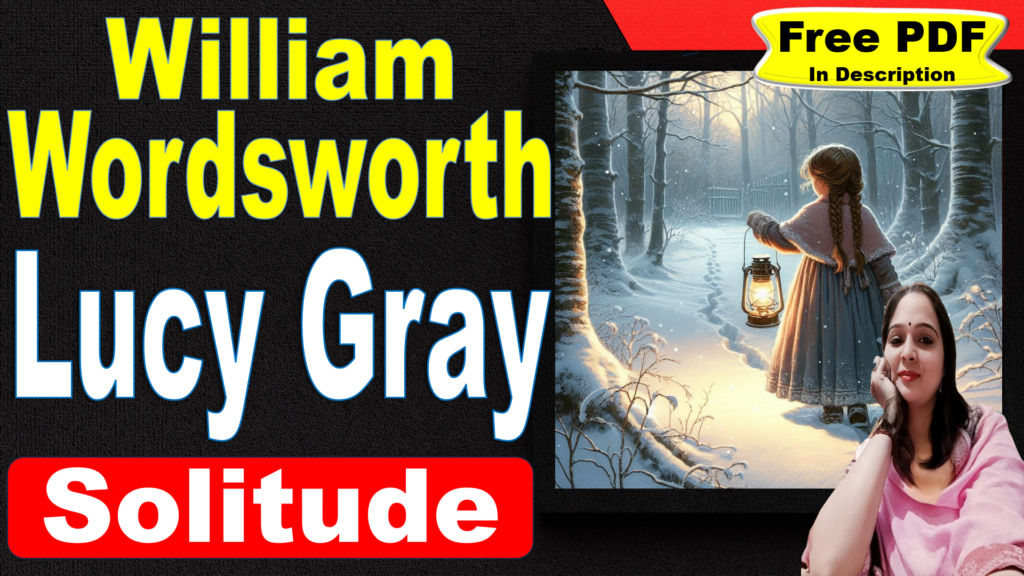
Lucy Gray Poem Questions Answers
Very Short Answer Questions
Q: Who is the central character in the poem “Lucy Gray”?
A: Lucy Gray.
Q: What does Lucy Gray carry with her on her journey?
A: A lantern.
Q: What time does the Minster-clock strike in the poem?
A: Two o’clock.
Q: What kind of night is predicted for Lucy Gray’s journey?
A: Stormy.
Q: Where does Lucy Gray live?
A: On a wild Moor.
Q: How is Lucy Gray described in relation to her surroundings?
A: The sweetest thing beside a human door.
Q: What does Lucy Gray’s father ask her to do?
A: To light her mother through the snow.
Q: What kind of weather complicates Lucy Gray’s journey?
A: A storm.
Q: What do Lucy Gray’s parents do when they realize she is missing?
A: They shout and search far and wide.
Q: What do Lucy Gray’s parents find in the snow at dawn?
A: The print of Lucy’s feet.
Q: How do Lucy Gray’s parents trace her path?
A: By following her footprints.
Q: What is the final location where Lucy Gray’s footprints end?
A: The middle of a plank on a bridge.
Q: What is suggested about Lucy Gray’s fate in the last stanza?
A: That she might still be alive and seen on the lonesome Wild.
Q: How does the poem describe Lucy Gray’s movement through the snow?
A: Her feet disperse the snow, rising up like smoke.
Q: What emotion is primarily evoked by the poem?
A: Melancholy.
Q: What is the landscape like where Lucy Gray lives?
A: Desolate and wild.
Q: What is the name of the child in the poem?
A: Lucy Gray.
Q: What do the parents do at day-break?
A: They stand on a hill and see the bridge.
Q: How does Lucy Gray’s father react when he sends her out?
A: He raises his hook and snaps a faggot-band.
Q: What does Lucy Gray do after taking the lantern?
A: She sets out through the snow.
Q: What is the purpose of the lantern in Lucy Gray’s journey?
A: To light her mother’s way through the snow.
Q: What do Lucy Gray’s parents use to track her?
A: Her footprints in the snow.
Q: How do the footprints help Lucy Gray’s parents?
A: They guide them to the bridge.
Q: What does the poem suggest about Lucy Gray’s existence in the end?
A: She may be a ghostly presence in the wild.
Q: What natural element is prominent in the poem?
A: Snow.
Q: What is the tone of the poem?
A: Melancholic and reflective.
Q: How does Lucy Gray’s journey end?
A: Her footprints end at the bridge with no further trace.
Q: What is one of the poem’s central themes?
A: Isolation.
Q: How is the setting of the poem described?
A: Wild and remote.
Q: What does Lucy Gray’s solitary song symbolize in the final stanza?
A: Her enduring presence in the wild.
Short Answer Questions
Q: Describe the setting of “Lucy Gray” and its significance to the poem.
A: The setting of the poem is a wild, desolate moor, which reflects Lucy Gray’s isolation and the harshness of her journey. The remote and bleak landscape enhances the poem’s themes of solitude and the struggle against nature.
Q: What is the primary task that Lucy Gray is given, and how does it reflect her character?
A: Lucy Gray is tasked with carrying a lantern through a storm to guide her mother safely. This task reflects her dutiful and selfless nature, as she willingly undertakes the dangerous journey despite the storm, demonstrating her commitment to her family.
Q: How do Lucy Gray’s parents react when they realize she is missing, and what does this reveal about them?
A: Lucy Gray’s parents frantically search for her throughout the night, shouting far and wide. Their desperate search reveals their deep concern and love for her, as well as the emotional impact of her disappearance on them.
Q: Explain the significance of the footprints in the snow in the poem.
A: The footprints in the snow are crucial as they serve as the only evidence of Lucy Gray’s path. They guide her parents to the bridge where her trail ends, symbolizing both hope and the finality of her disappearance.
Q: What is suggested about Lucy Gray’s fate in the final stanza, and how does this affect the poem’s tone?
A: The final stanza suggests that Lucy Gray may still be alive as a ghostly presence in the wild, continuing to wander and sing. This adds a mystical and haunting quality to the poem, affecting its tone by blending melancholy with an eerie sense of mystery.
Q: How does the poem use imagery to enhance the theme of isolation?
A: The poem uses vivid imagery of the desolate moor, the stormy weather, and Lucy Gray’s solitary figure to underscore her isolation. Descriptions of her being the “sweetest thing” in a wild, lonely place emphasize her separation from society and her vulnerability.
Q: What role does the storm play in the narrative of the poem?
A: The storm serves as a formidable obstacle that prevents Lucy Gray from reaching the town and contributes to the tragic outcome of the poem. It symbolizes the unpredictable and often harsh nature of life, intensifying the sense of struggle and futility in her journey.
Q: How does the poem convey the emotional state of Lucy Gray’s parents?
A: The poem conveys their emotional state through their frantic search and distress. Their loud shouting and the despair they express when they realize they cannot find her illustrate their profound grief and helplessness.
Q: What is the symbolic meaning of the bridge in the poem?
A: The bridge symbolizes the threshold between life and death or the known and unknown. Lucy Gray’s footprints ending at the middle of the bridge suggest a crossing into another realm, adding a layer of symbolic meaning to her disappearance.
Q: How does Wordsworth’s depiction of nature contribute to the overall theme of the poem?
A: Wordsworth’s depiction of nature as both beautiful and harsh contributes to the theme of the poem by reflecting the internal and external struggles of Lucy Gray. The wild, stormy moor represents the unpredictable and sometimes cruel forces of nature, which play a significant role in the poem’s narrative and themes of isolation and tragedy.





